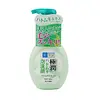What's inside
What's inside
 Key Ingredients
Key Ingredients

 Benefits
Benefits

 Concerns
Concerns

 Ingredients Side-by-side
Ingredients Side-by-side

Water
Skin ConditioningLauric Acid
CleansingSorbitol
HumectantPEG-75
HumectantMyristic Acid
CleansingPotassium Hydroxide
BufferingCocamide DEA
EmulsifyingDecyl Glucoside
CleansingButylene Glycol
HumectantDipotassium Glycyrrhizate
HumectantAminocaproic Acid
Coix Lacryma-Jobi Ma-Yuen Seed Extract
Skin ConditioningHouttuynia Cordata Extract
Skin ConditioningAnthemis Nobilis Flower Extract
MaskingSodium Hyaluronate
HumectantSqualane
EmollientCamphor
MaskingGlycerin
HumectantRosmarinus Officinalis Leaf Oil
MaskingPalmitic Acid
EmollientMenthoxypropanediol
MaskingPEG-80 Sorbitan Laurate
Steareth-20
CleansingSodium Bicarbonate
AbrasivePolyquaternium-39
Disodium EDTA
Alcohol Denat.
AntimicrobialIodopropynyl Butylcarbamate
PreservativePhenoxyethanol
PreservativeWater, Lauric Acid, Sorbitol, PEG-75, Myristic Acid, Potassium Hydroxide, Cocamide DEA, Decyl Glucoside, Butylene Glycol, Dipotassium Glycyrrhizate, Aminocaproic Acid, Coix Lacryma-Jobi Ma-Yuen Seed Extract, Houttuynia Cordata Extract, Anthemis Nobilis Flower Extract, Sodium Hyaluronate, Squalane, Camphor, Glycerin, Rosmarinus Officinalis Leaf Oil, Palmitic Acid, Menthoxypropanediol, PEG-80 Sorbitan Laurate, Steareth-20, Sodium Bicarbonate, Polyquaternium-39, Disodium EDTA, Alcohol Denat., Iodopropynyl Butylcarbamate, Phenoxyethanol
Water
Skin ConditioningGlycerin
HumectantGlycylglycine
Butylene Glycol
HumectantHydroxypropyl Starch Phosphate
Cocamidopropyl Betaine
CleansingPEG-400
Emulsion StabilisingDecyl Glucoside
CleansingZinc Lauroyl Aspartate
Tea-Cocoyl Glycinate
CleansingSodium Stearoyl Glutamate
CleansingGlyceryl Stearate
EmollientHyaluronic Acid
HumectantHydroxypropyltrimonium Hyaluronate
Citric Acid
BufferingStearic Acid
CleansingLauric Acid
CleansingPEG-32
HumectantDisodium EDTA
Polyquaternium-7
Hydroxypropyl Methylcellulose
Emulsion StabilisingPolyquaternium-52
Methylparaben
PreservativePropylparaben
PreservativeBHT
AntioxidantWater, Glycerin, Glycylglycine, Butylene Glycol, Hydroxypropyl Starch Phosphate, Cocamidopropyl Betaine, PEG-400, Decyl Glucoside, Zinc Lauroyl Aspartate, Tea-Cocoyl Glycinate, Sodium Stearoyl Glutamate, Glyceryl Stearate, Hyaluronic Acid, Hydroxypropyltrimonium Hyaluronate, Citric Acid, Stearic Acid, Lauric Acid, PEG-32, Disodium EDTA, Polyquaternium-7, Hydroxypropyl Methylcellulose, Polyquaternium-52, Methylparaben, Propylparaben, BHT
 Reviews
Reviews

Ingredients Explained
These ingredients are found in both products.
Ingredients higher up in an ingredient list are typically present in a larger amount.
Butylene Glycol (or BG) is used within cosmetic products for a few different reasons:
Overall, Butylene Glycol is a safe and well-rounded ingredient that works well with other ingredients.
Though this ingredient works well with most skin types, some people with sensitive skin may experience a reaction such as allergic rashes, closed comedones, or itchiness.
Learn more about Butylene GlycolDecyl Glucoside is a glucose-based surfactant and emulsion stabilizer. It is created by reacting glucose with the fatty acids from plants.
Surfactants help clean the skin by trapping oil, sebum, and dirt to be washed away. As an emulsion stabilizer, it stabilizes the ingredients in a product by preventing them from separating.
This ingredient is biodegradable and non-toxic. This ingredient is commonly found in baby shampoos.
Decyl Glucoside is sometimes used to stabilize the UV filter Tinosorb.
Learn more about Decyl GlucosideDisodium EDTA plays a role in making products more stable by aiding other preservatives.
It is a chelating agent, meaning it neutralizes metal ions that may be found in a product.
Disodium EDTA is a salt of edetic acid and is found to be safe in cosmetic ingredients.
Learn more about Disodium EDTAGlycerin is already naturally found in your skin. It helps moisturize and protect your skin.
A study from 2016 found glycerin to be more effective as a humectant than AHAs and hyaluronic acid.
As a humectant, it helps the skin stay hydrated by pulling moisture to your skin. The low molecular weight of glycerin allows it to pull moisture into the deeper layers of your skin.
Hydrated skin improves your skin barrier; Your skin barrier helps protect against irritants and bacteria.
Glycerin has also been found to have antimicrobial and antiviral properties. Due to these properties, glycerin is often used in wound and burn treatments.
In cosmetics, glycerin is usually derived from plants such as soybean or palm. However, it can also be sourced from animals, such as tallow or animal fat.
This ingredient is organic, colorless, odorless, and non-toxic.
Glycerin is the name for this ingredient in American English. British English uses Glycerol/Glycerine.
Learn more about GlycerinLauric Acid is a fatty acid or lipid. About half of fatty acids in coconut oil is lauric acid.
This ingredient helps hydrate and sooth skin. As a humectant, it helps trap moisture. It also aids in cleaning and enhancing the texture of products.
Lauric acid may not be Malassezia folliculitis, or fungal acne, safe.
Learn more about Lauric AcidWater. It's the most common cosmetic ingredient of all. You'll usually see it at the top of ingredient lists, meaning that it makes up the largest part of the product.
So why is it so popular? Water most often acts as a solvent - this means that it helps dissolve other ingredients into the formulation.
You'll also recognize water as that liquid we all need to stay alive. If you see this, drink a glass of water. Stay hydrated!
Learn more about Water